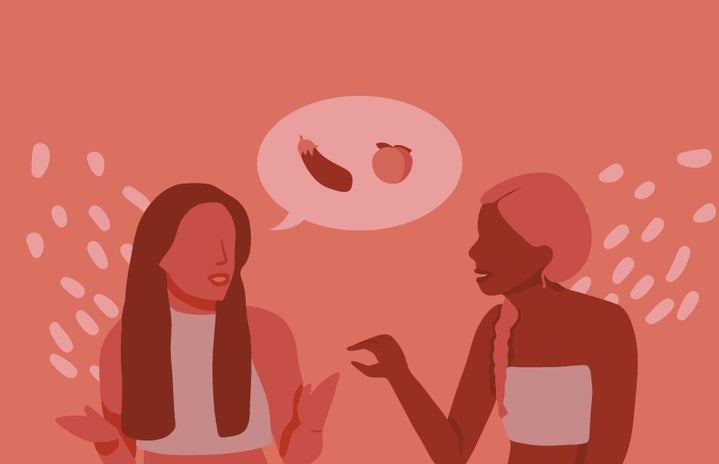It seems that BDSM is the new vanilla. Throughout visual and textual media, men are being idealized for acting sexually aggressive towards women: just look at the popularity of Fifty Shades of Grey. Once considered taboo, the concept of choking your partner during sex has entered the mainstream of conversation.
I can’t tell you how many times a man has approached me saying that they’d love to beat the shit out of me. On a more subtle note, sometimes I get an invitation along the lines of “You look like you’re into BDSM. Let me show you what I can do.”
While I have every reason to assume these bold men are drastically compensating for something, the truth is there’s nothing wrong with partaking in BDSM—as long as it’s done safely. It’s an activity that carries a severe set of risks from committing rape to leaving behind emotional turmoil, rope burn and broken bones. When someone chooses to call themselves a dominant or daddy, yet won’t do the necessary research, they can cause drastic harm to their partner.
It’s common for sexual assault victims to find empowerment in choosing to participate in BDSM: as a sub, they gain power over a traumatizing situation by willingly choosing to partake in it. However, they could be triggered or retraumatized if the necessary precautions and safe practices, such as establishing and respecting safe words, are bypassed. Additionally, submissive men and women who are beginning to explore their sexuality don’t always know how to stand up for the treatment they deserve. Due to nerves or inexperience, they are easily taken advantage of and harmed by irresponsible or lazy abusers posing as doms.
There are also massive risks in misrepresenting BDSM in the mainstream culture as an expected component of “normal” vanilla sex. Women especially are trained to expect violence to be a natural component of healthy sex, even when they aren’t comfortable in participating in that kind of behaviour. They’re taught to believe that men not only desire but require violence to be interwoven with sexual intimacy: that being beaten or choked is something they need to experience in order to please their partner, or partake in sex at all. This way of thinking is extremely problematic for women’s mental and physical well being, especially when it becomes a requirement in their relationships. How many women are told that sex is supposed to hurt, or to expect blood during their first sexual experience?
Not every person is turned on by kink or violent sex: those who are usually discover that through their own desires, or fantasies. While it’s alright to experiment following proper communication, throwing your partner into a kinky experience or full-on scene can be shocking, and not necessarily in a pleasant way. Not everyone wants to be choked, and it’s dangerous to assume they do.
Many men hop on the BDSM train relatively quickly, posting online about being true doms, daddies and experts in dirty talk. It’s frankly pathetic; many of these self-proclaimed kinksters will become the subject of ridicule by those in the community. These men, who we in the community term “Tumblr doms”, aren’t truly interested in BDSM: they’re insecure, power-hungry boys who fantasize about being called daddy, but barely know their way around a bedroom. At the very least, they don’t have a working knowledge of BDSM practices—or seem to want one. In Facebook groups such as “Yes sir daddy master domly mcdompants, the most domly dom to ever dom”, it’s not uncommon to see screenshots of dating profiles of self-proclaimed doms looking for a very specific, submissive woman: one “without boundaries” who would be “down for anything”.
The truth is, kink isn’t just about satisfying what turns you on as an individual—it’s supposed to be an enjoyable experience for both partners, dependent on trust and the ability to work together. It’s obvious from the aggression that Tumblr doms aren’t truly interested in BDSM—they’re turned on by the idea of harming women and getting away with it. This could be due to a variety of factors, including the misinformed “representation” depicted in Fifty Shades and aggressive porn, a belief in sexual entitlement, repressed anger or the extremities of traditional gender norms.
Even if we put aside the idealized violence and lack of care for their partners, it’s obvious that these men don’t truly align with the idea of BDSM. Domination and sadism are hot, sure, but only when it’s done at the hands of men: they pale at the idea of women being dominants. Remember that man who said I looked like I’d be into BDSM? Imagine his reaction when I told him “(his) ass would be the one getting wrecked”.
Tumblr doms don’t want women to have autonomy or empowerment in their sexuality at all. They want sex slaves—not just in role play, but in the real sense of the word. Real dominant men accept that there are dominant women in the community—and furthermore, they are more than comfortable to discuss boundaries with their sub and respect the word no.
It’s said that people who engage with true BDSM are happier and have healthier relationships—this is because of the communication and trust that’s so essential to the BDSM experience. The practice requires a lot of research, communication and trial and error. While this additional work can be daunting to newcomers, the benefits of the experience are often worth the effort.
If you’re interested in BDSM but don’t know where to begin, I’ve got your back. As I said previously, you’ve got to do your research. Some sources I recommend are: the BDSM blog posts on Lelo, BDSM educator Evie Lupine and the BDSM Test, which can be taken to learn more about your place on the BDSM spectrum.
At the very least, no one should attempt BDSM without a thorough knowledge of what I call the two essentials: consent and aftercare.
Consent
I shouldn’t have to say this, but if you’re the kind of person who laughs at rape jokes, BDSM isn’t for you. I don’t give a fuck if you’ve found someone who shares your “rape fantasy”—they don’t actually want to be raped. They want the feeling of being overpowered, within reasonable bounds. They’re not asking to be truly violated.
Engaging in consensual non-consent is not the same as ignoring your partner’s lack of consent. Don’t know what I’m talking about? Do your fucking research.
Consensual non-consent, just like any other form of kink and vanilla sex, requires the practice of clear communication. Doms need to discuss boundaries with their subs before engaging in a sexual scene: what are they comfortable with? Are there any acts or places that are triggering for them?
Prior to having any form of sex, it’s common for doms and subs to have negotiations: in other words, take the time to create inclusive or exclusive lists. Inclusive lists are made by discussing what partners are willing to experience: anything not listed is off the table. Exclusive lists involve discussing what partners will not partake in: anything else is, unless discovered to be harmful, fair game.
Regardless of which form of negotiation partners use, it’s crucial that they establish a safe word. That safe word stops all play, no matter how much the opposite party is enjoying what is happening.
The hard truth is that even though doms get off on the feeling of being in control, the sub is the one with all the power. They’re deciding what they are and aren’t comfortable with: the dom only gets to play within the boundaries their sub sets. If a dom is disrespecting a boundary, traumatizing or violating their sub and enjoying it? They’re not participating in BDSM. They’re actively committing rape.
Aftercare
As a dom, it’s my responsibility to care for my sub. I can’t simply degrade or beat the shit out of him during sex and expect him to be perfectly fine afterwards: it would be more than disrespectful to him.
Even though rough sex is agreed upon in advance, that doesn’t mean it’s always easy to fully experience. Many subs (and even doms) experience what’s known as drop: partners on both ends can feel weak, tired, depressed, disgusted or dazed from spikes of physical exertion, adrenaline and endorphins. Aftercare helps ease partners back to a steady state: it functions as a form of recalibration, returning both partners to the relationship’s mode of functioning outside of the bedroom.
There are two types of aftercare: physical and emotional. Physical aftercare is exactly what it sounds like: taking care of the body, whether that means providing something sweet to maintain blood sugar levels, removing your partner’s restraints, or providing kisses or soft touches to sensitive areas. Emotional aftercare takes care of your partner’s psychological state. This can include reassuring or praising your partner, or discussing how the sex was: what was good? Is there anything that happened which you should avoid doing in the future?
Aftercare should also be discussed prior to engaging in any BDSM act. Everyone’s needs are different. Some need an abundance of physical affection, whereas others prefer to “come down” from the experience alone. For me, taking care of my sub is a part of the pleasure: there’s nothing better than pulling my man into my lap, running my fingers through his hair and telling him what a good boy he’s been for me.
While aftercare doesn’t need to be your favourite thing, both subs and doms need it. If you’re unwilling to provide aftercare, or if it feels like a chore to you, you’re not really interested in BDSM.
BDSM can be an incredibly rewarding experience, but it’s not something that should be entered into lightly. Like any serious partnership, it involves a significant amount of communication, mutual respect and work. It’s a labour of love—but those who like it, really like it.
Related Articles
- Why I Cry During Sex
- How I Broke Free From the Stereotype of Hypersexuality
- Birth Control Breakdown
Want more HCW? Check us out on social media!
Facebook, Twitter, Instagram, Pinterest
Subscribe to our newsletter!



